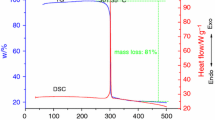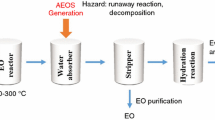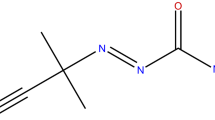Abstract
The solubility of RDX (hexahydro-1,3,5-tri-nitro-1,3,5-triazine) in TNT (2,4,6-trinitrotoluene) at elevated temperatures is required to accurately predict the response of Comp-B3 (60:40 RDX:TNT) during accidents involving fire. As the temperature increases, the TNT component melts, the RDX partially dissolves in the liquid TNT, and the remaining RDX melts (203 \(^\circ\)C) as the Comp-B thermally ignites. In the current work, we used a differential scanning calorimeter (DSC) to estimate the solubility of RDX in TNT at the melting point of RDX. Most DSC measurements of Comp-B3 do not show an RDX melt endotherm. The absence of an endotherm associated with the RDX melt has been interpreted as RDX being completely dissolved in TNT before reaching the melting point. We have observed that the endotherm is not absent, but is masked by exothermic reactions occurring at these elevated temperatures. We have inhibited the exothermic reactions by venting our DSC samples and measuring the RDX melt endotherm in our Comp-B3 samples at about 203 \(^\circ\)C. Using the measured heat flow associated with the RDX melt and the latent melting enthalpy of RDX, we have approximated the solubility of RDX in TNT to be roughly 50–100 \(\hbox {g}_{\mathrm{RDX}}\) per 100 \(\hbox {g}_{\mathrm{TNT}}\). The broad range is based on corrections for exothermic reactions occurring as the RDX melts.






Similar content being viewed by others
References
Manelis G, Nazin G, Rubtsov Y, Strunin V. Thermal decomposition and combustion of explosives and propellants. New York: Taylor and Francis; 2003.
Jia Q, Kou K, Zhang JQ, Zang S, Xu Y. Study on the dissolution behaviors of CL-20/TNT co-crystal in N, N-dimethylformamide (DMF) and dimethyl sulfoxide (DMSO). J Therm Anal Calorim. 2018;134(3):2375–82.
Hobbs ML, Kaneshige MJ, Erikson WW. Modeling the measured effect of a nitroplasticizer (BDNPA/F) on cookoff of a plastic bonded explosive (PBX 9501). Combust Flame. 2016;173:132–50.
Campbell AN, Kushnarov HA. A study of systems involving trinitrotoluene, RDX, NENO, and dinitrobenzene, with particular reference to the composition of the binary eutectics. Can J Res. 1947;25(B):216–27.
Parker RP, Thorpe BW. Technical note 140 the phase diagram of the RDX-TNT system. Victoria: Australian Defense Scientific Service; 1970.
Jaansalu KM. Phase diagram modeling of cast energetic materials. In: Insensitive munitions and energetic materials symposium, Rome; 2015. p. 1–11.
Myint PC, McClelland MA, Nichols AL III. Application of the Peng–Robinson equation of state to energetic materials RDX and TNT: pure components, liquid mixtures, and solid mixtures. Ind Eng Chem Res. 2016;55:2252–66.
McClelland MA, Glascoe EA, Nichols AL III. ALE3D simulation of incompressible flow, heat transfer, and chemical decomposition of CompB in slow cookoff experiments. In: 15th international detonation symposium, San Francisco; 2014. p. 1196–206.
Krawietz TR, McKenney RL Jr, Ortiz RJ, Characterization of the unconfined slow cookoff response of nitramines and nitramine composites with TNT. In: 12th international detonation symposium, San Diego; 2002. p. 79–86.
Gibbs TR, Popolato A. LASL explosive property data. Los Angeles: University of California Press; 1980.
Song X, Li F. Dependence of particle size and size distribution on mechanical sensitivity and thermal stability of hexhydro-1,3,5-trinitro-1,3,5-triazine. Def Sci J. 2009;59:37–42.
McGuire RR, Tarver CM. Chemical decomposition models for the thermal explosion of confined HMX, TATB, RDX, and TNT explosives. In: Seventh symposium (international) on detonation, Annapolis; 1981. p. 56–64.
Department of the Army. Military explosive army technical manual TM9-1300-214. Washington, DC: US Army Material Command; 1984.
Acknowledgements
Sandia National Laboratories is a multimission laboratory managed and operated by National Technology & Engineering Solutions of Sandia, LLC, a wholly owned subsidiary of Honeywell International Inc., for the U.S. Department of Energy’s National Nuclear Security Administration under contract DE-NA0003525. The authors acknowledge partial support of this work from the Joint DoD/DOE Munitions Program. This paper describes objective technical results and analysis. Any subjective views or opinions that might be expressed in the paper do not necessarily represent the views of the U.S. Department of Energy or the United States Government. We would like to thank Bob Patton for running the PDSC experiments, Shane Snedigar for running the SITI experiments, Marcia Cooper and Stephanie Coronel for internal review, and Sophia Lefantzi, Leanna Minier, and Clint Hall for management support. We also would like to thank Matt McClelland for providing the DSC data used in Fig. 4d.
Author information
Authors and Affiliations
Corresponding author
Ethics declarations
Conflict of interest
The authors declare that they have no conflict of interest.
Additional information
Publisher's Note
Springer Nature remains neutral with regard to jurisdictional claims in published maps and institutional affiliations.
Rights and permissions
About this article
Cite this article
Hobbs, M.L., Kaneshige, M.J., Todd, S.N. et al. RDX solubility in TNT at high temperatures. J Therm Anal Calorim 142, 861–869 (2020). https://doi.org/10.1007/s10973-019-08924-z
Received:
Accepted:
Published:
Issue Date:
DOI: https://doi.org/10.1007/s10973-019-08924-z




